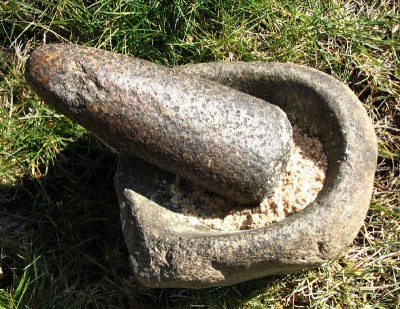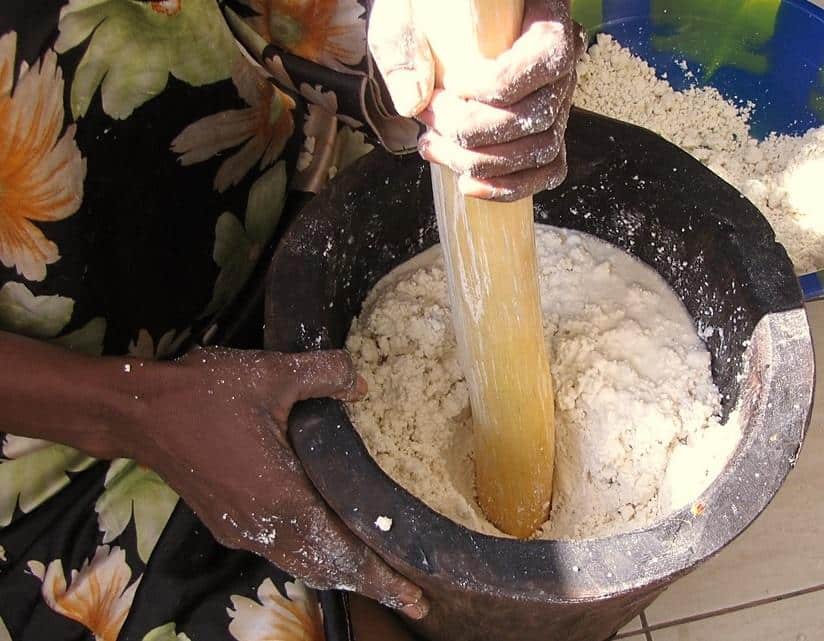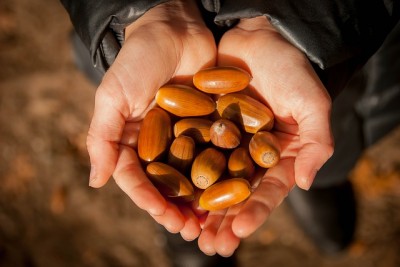We’re accustomed to wheat as the gold standard for making flour. And while we often think of whole wheat flour as different than white bleached flour, the source for both is still wheat.
The challenge with producing your own flour is the amount of acreage needed to plant sufficient wheat, which is also a high-maintenance crop. Growing wheat may distract from more important work, but that doesn’t mean flour has to be off the menu.
In this article, we’re going to cover some common plants and trees that produce various types of seeds and roots that can be crushed into flour. We’ll include information on harvesting, processing, and also some basics about baking. The primary sources we’ll explore include grasses like rye grass, weeds like amaranth, nuts like acorns, and roots or tubers like cattails.
One of the reasons wheat has emerged and evolved as our primary source of flour is the ease associated with its processing. Wild sources of flour can get a bit more complicated, and sometimes require crushing the source into a wet mash and dehydrating or straining it before pulverizing it into dusty flour.
Learn How You Can Make Powerful Herbal Medicines, Right in Your Kitchen!
Regardless of the source, it takes a lot of raw material to make flour. It’s possible you may only find a small quantity of any one plant, nut or root. That’s why you should consider combining resources to make a blended flour. This could be the roots from cattails plus acorns and amaranth. It essentially creates a multi-grain bread with a nutrient profile that would put it in the category of a superfood.
A Few Words on Technique
The standard approach to making flour from wheat is to harvest the wheat when it has matured and is amber brown, and then cut the stalks and harvest the seeds. Most of us have heard the phrase “separate the wheat from the chaff.” This involves tossing the wheat kernels into a light breeze and allowing the outer coating surrounding the wheat kernels to blow from the heavier wheat seed, which is captured in a wide basket below.
We’ll follow the same technique for rye grass and amaranth, but the approach and technique for cattails and acorns is a bit different and a tad more complicated.
Processing Flour
 In order to make a flour, you have to pulverize something into what is essentially a dust. You can purchase a hand-cranked flour mill, which resembles a meat grinder. You also can crush the wheat in between a large river rock about 4 to 5 inches in diameter and a rock with a flat surface. Igneous rocks like granite are best, because sedimentary rocks like limestone and sandstone will eventually break down and become part of the flour. (Archaeologists have determined from Egyptian mummies that a common affliction affecting Egyptians was the erosion and loss of tooth enamel because the grains they ate were largely processed with sandstone and limestone mill wheels.)
In order to make a flour, you have to pulverize something into what is essentially a dust. You can purchase a hand-cranked flour mill, which resembles a meat grinder. You also can crush the wheat in between a large river rock about 4 to 5 inches in diameter and a rock with a flat surface. Igneous rocks like granite are best, because sedimentary rocks like limestone and sandstone will eventually break down and become part of the flour. (Archaeologists have determined from Egyptian mummies that a common affliction affecting Egyptians was the erosion and loss of tooth enamel because the grains they ate were largely processed with sandstone and limestone mill wheels.)
Mortar and Pestle Techniques
A mortar and pestle involves a hollow, sloping bowl (the mortar) and a rounded, thinner and elongated pestle. These vary in size from a few inches to a few feet in length. The standard mortar and pestle concept used for flour making was often seen in primitive cultures, where a large log is hollowed out to create a deep, sloping bowl and a pestle is shaped from a log 3 to 6 inches in diameter. The log pestle is raised and dropped repeatedly into the grain, root or nut source until it’s pulverized into a powder.
The Food Processor
This is a cheat from an off-the-grid standpoint, but anything can be processed into a flour with a food processor. The key is that the source material must be as dry as possible. Any remaining moisture will result in a mash rather than a flour. If you end up with a mash, it can be dried, but it’s far more time consuming.
The Gluten Factor
If you’re looking for gluten-free alternatives, you’re in luck. These types of natural, wild flour sources are either gluten free or, in the case of rye grass, very low in gluten. On the downside, gluten is the ingredient that helps a bread or baked good rise, as well as have a soft and smooth texture. Yeast and sugar can help to compensate, as can honey and using a sourdough starter. The bottom line is that these types of flours will result in a very rustic style of bread or baked item that will be denser than a store-bought item or a homemade, wheat-based bread.
The Sources
1. Amaranth – Amaranth is a weed, but I prefer to think of it as an indigenous plant common across North and South America that produces a seed stalk. The seed stalks of the amaranth range in size from 4 to 8 inches in length and are packed with thousands of seeds. The plants grow prolifically and reseed easily as annuals.
An easy way to begin an amaranth planting is to simply buy the seeds in bulk at a grocery store that sells amaranth for cooking. Cast the seeds on the ground in spring, and some plants will grow. Just remember: They spread rapidly and widely over the years.
Harvest the seeds in the fall, and prepare a space where the seeds can dry out, such as in the rafters of an attic or sunny window. They can be processed with any of the techniques we’ve identified.
2. Acorns – Acorns are best harvested in the fall after they’ve fallen to the ground. They need to be dried, and the best way is to roast them. Take the cap off of the acorn and score them on one side with a knife. Place them on a baking sheet in an oven heated to 250 degrees Fahrenheit, or in a Dutch oven over hot coals. Toss them every 10 minutes up to an hour until you can cut one in half to reveal a dried, acorn nut.
Acorns are bitter due to the tannic acid or “tannins” that permeate them. To get rid of the tannins, you need to coarsely crush the acorns and soak them in water after a short roast. You then need to dry or dehydrate them again. This may take more than one soak, so taste as you go until the bitterness is gone.
3. Rye grass – Rye grass is a tall grass 3 to 4 feet in height. The seeds are long and narrow and distinct from some of the small seed heads on other grasses. Annual rye grass provides larger seed heads than perennial rye grasses, because annuals are so dependent on reseeding for proliferation.
Rye grass should be harvested in the fall when the grasses are browned and mature. The grass is shaken over a large basket and the seed heads are sometimes beaten with a stick to release the seeds. The seeds are then tossed and crushed by hand, and the wind is used to separate the rye seed from the chaff. The heavier rye seeds are captured in a fine mesh basket or container.
4. Cattails – Peel the wet roots and chop them into small pieces and then pound them with a little water to make a mash. There will be some fibers, so strain the mash through a screen. The resulting flour mash should then be left to dry and can be crushed into flour using any of the techniques we’ve identified.
Cattails are actually an excellent flour resource. In the early 1940s, cattails were essentially isolated to marshes on coastal areas of the east and west coast of North America. But during World War II, the government began a widespread program to distribute the seeds in order to jumpstart a new, alternative flour program. While the program was suspended after the war ended in 1945, the cattails you see across the country today are the results of the program.
Storage
I usually store any wild flour in a sealed container or plastic bag in a cool, dark place. I use it as a replacement in standard recipes calling for flour, with the understanding that it will result in a denser, coarser baked result. Ultimately, you’ll have to experiment with wild flour blends to see what works best for you.
Have you ever made flour? What advice would you add? Share it in the section below:
Every Year, Gardeners Make This Dumb Mistake — But You Don’t Have To. Read More Here.
 Off The Grid News Better Ideas For Off The Grid Living
Off The Grid News Better Ideas For Off The Grid Living





